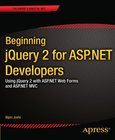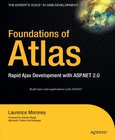Beginning Ajax with ASP.NET

Book Details:
| Publisher: | Wrox |
| Series: | Wrox , Beginning |
| Author: | Wallace B. McClure |
| Edition: | 1 |
| ISBN-10: | 047178544X |
| ISBN-13: | 9780471785446 |
| Pages: | 500 |
| Published: | Sep 05 2006 |
| Posted: | Nov 19 2014 |
| Language: | English |
| Book format: | |
| Book size: | 6.92 MB |
Book Description:
Ajax has the power to revolutionize the way web-based applications are designed. This book provides you with a thorough working knowledge of what Ajax has to offer and how to take full advantage of it in your application development.Following an exploration of how Ajax works with .NET, you'll get acquainted with DHTML, the role of JavaScript and the Document Object Model, and the XMLHttpRequest Object, which is the foundation of Ajax. Then you will examine the Ajax-type features built into ASP.NET and explore the Ajax.NET Professional Library in detail. Finally, you will explore client scripting as well as building and using controls with Microsoft's Atlas. With an entire chapter devoted to debugging, you will have all you need to use this cutting-edge technology.What you will learn from this book* What you can do with the open source Ajax.NET Professional Library* How to use the corresponding functionality, Asynchronous Client Script Callbacks, that comes with ASP.NET 2.0* Techniques for using the XMLHttpRequest Object to communicate between the client web browser and the server* An overview of XML, XSLT, and other ways to send data between client and server* How to integrate Microsoft's Atlas with many of the services available in ASP.NET 2.0Who this book is forThis book is for programmers who use ASP.NET and are just starting to use Ajax technologies to create more responsive, modern applications.Wrox Beginning guides are crafted to make learning programming languages and technologies easier than you think, providing a structured, tutorial format that will guide you through all the techniques involved.
Download Link:
Related Books:
Programming ASP.NET AJAX
Build rich, Web 2.0-style UI with ASP.NET AJAX
Delivering rich, Web 2.0-style experiences has never been easier. This book gives you a complete hands-on introduction to Microsoft ASP.NET AJAX 1.0, the new framework that offers many of the same benefits for Ajax development that ASP.NET provides for server-side development. With Programming ASP.NET AJAX, you'll learn how to create professional, dynamic web pages with Ajax in no time. Loaded with code and examples that demonstrate key aspects of the framework, this book is ideal not only for ASP.NET developers who want to take their applications a step further with Ajax, but for any web developers interested in ASP.NET AJAX, no matter what technology they use currently. That includes JavaScript programmers who would like to avoid the headaches of w...
Beginning jQuery 2 for ASP.NET Developers
Using jQuery 2 with ASP.NET Web Forms and ASP.NET MVC
jQuery is the most popular JavaScript library in use today, appearing on nearly two thirds of the10,000 most visited sites on the web. With this sort of popularity, its clear that ASP.NET developers cant afford to miss out. By combining jQuerywith ASP.NET you get the best of both worlds: the client-side interactivity and responsiveness of JavaScript with the robustness and extensibility of Microsoft's web stack. Beginning jQuery 2 for ASP.NET Developers shows you how. To begin with, you'll find out how jQuery hooks up with your ASP.NET controls, and simplifies event handling by keeping it in the browser. Then you'lllearn tohandle dynamic content and responsive layouts byinteracting withthe DOM.Effects and animations are one of the most popular u...
Foundations of Atlas
Rapid Ajax Development with ASP.NET 2.0
This book introduces a fast-track path to understanding Atlas, and how this technology can increase the power and functionality of your code while conserving time and effort. The book begins with a bare-bones introduction that explains how Atlas relates to Ajax. Microsoft Atlas is a web-client framework that makes building Ajax-style applications easier. It provides a prewritten framework that gives you a structured environment in which to work. Atlas also provides you with an object model and standardized debugging to make development faster and simpler. Ajax is a way of combining a number of Web technologies including JavaScript, dynamic HTML, and a feature known as XMLHttp (which reduces the need for client browsers to constantly reconnect to the ...
2007 - 2021 © eBooks-IT.org



